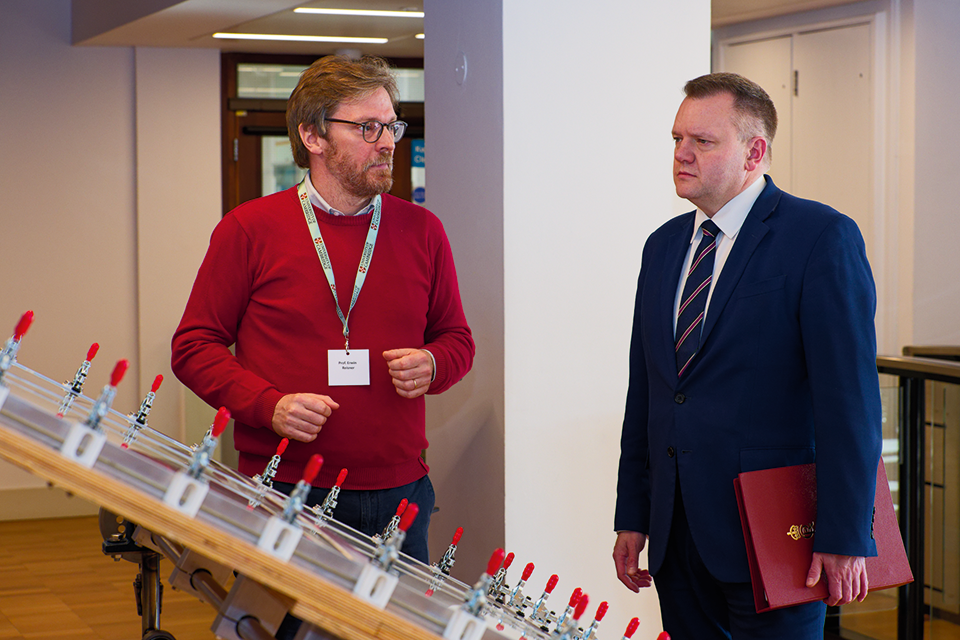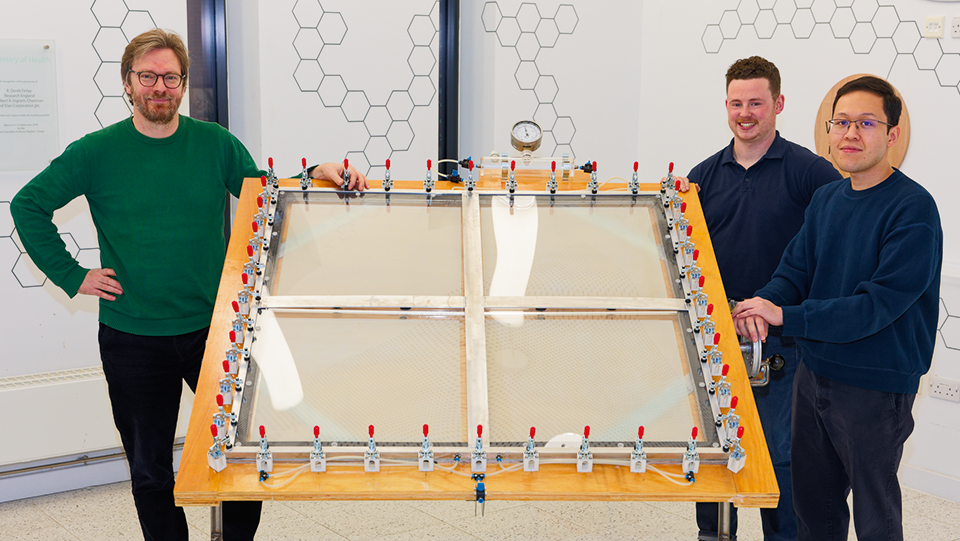
Shaun Impey stand infront of the solar reactor taken by Michael Webb ©University of Cambridge
In our outstanding workshop teams, skilled professionals across several disciplines contribute to the success of our Department. Among them is Shaun Impey, a dedicated mechanical engineer who built a metre-squared solar reactor.
In our outstanding workshop teams, skilled professionals across several disciplines contribute to the success of our Department. Among them is Shaun Impey, a dedicated mechanical engineer who built a metre-squared solar reactor for the Reisner Lab’s work on upscaling their waste-to-hydrogen technology.
While he originally trained in carpentry, Shaun joined the Department under a Higher Apprenticeship in Mechanical Engineering. He has since transitioned fully into mechanical engineering, bringing valuable hands-on experience to the Mechanical Workshop – just one of the many specialist workshops that support our students and staff. Thanks to his experience and his out-of-the-box problem-solving skills, the one metre-squared reactor was a successful proof-of-concept and there are certainly more bespoke builds in his future.
Solar reactor
The solar reactor makes hydrogen from aqueous waste solutions using sunlight as an energy source and a catalyst to enable the reaction. This is a clean source of hydrogen fuel and helps reuse biomass or plastic waste that is otherwise burned or sent to landfill. Prototype solar reactors can be quite small and more straightforward to build, but this research is upscaling the science from the lab bench to the real world.

Prof. Erwin Reisner demonstrates the solar reactor to MP Nick Thomas-Symonds taken by Michael Webb ©University of Cambridge.
Shaun’s background
Before joining the Department in 2018, Shaun found himself redundant from his carpentry job making wardrobes and the Department workshop was a great next challenge.
“When I arrived, it was a very different workplace to what I was used to, a lot of different tools to learn but now it all just feels like second nature. As a woodworker, I used drills, saws and sanders but now the demands are more varied: welding, laser cutting, computer numerical controlled milling machines, just about everything. I used to work from someone else’s design to make wardrobes but now I do everything from initial concept to finished product.”
Different projects at the workshop take different amounts of time and the reactor was one of Shaun’s larger projects taking six months. He can make smaller components, like custom replacement parts, in a few weeks and often with a much lower price tag.
The challenge
Shaun reflects that: “For me, the biggest design challenge was that this contraption needs to be liquid tight and airtight and it is also 1.1 metre squared.”
Additionally, a lot of Perspex on the market blocks UV light. This is useful for everyday use since UV light can damage skin but disastrous for the solar reactor which benefits from these powerful wavelengths to function. Fortunately, Shaun had an innovative solution:
“The only suppliers I could find in the UK that sold specialist Perspex that large were sun bed specialists. It had to be one sheet to guarantee that it was water tight.”
He also collaborated with the researchers to make the device versatile, choosing to seal the window with sixty clamps (bright red in the photos) as opposed to screwing the panel in so that the scientists could access the catalysts easily.
The results

Prof. Erwin Reisner, Ariffin Mohamad-Annuar and Shaun Impey stand behind the solar reactor that Shaun built taken by Michael Webb ©University of Cambridge.
One of these scientists is Ariffin Mohamad-Annuar, a third-year PhD student in the Reisner Lab, who led this research, which will be published later in the year. He wanted to upscale their smaller solar reactor prototypes into a large version that was designed to be modular and enable outdoor testing.
“One of the innovations is that we have a catalyst that we can spray onto the panel. Some catalysts need high temperatures or pressures when they are applied but this one is applied with a simple airbrush. It is convenient.”
The panel in the solar reactor began producing hydrogen gas when it was left outside in the sun. The team rotated it every hour-and-a-half for the most-direct sunlight. After the success of this panel, Ariffin will be working with the workshop again to design the next version of the solar reactor.
“We want to work another design next to make it more efficient and try out some new ideas.”
The benchtop cell
The Reisner Group entered an earlier, smaller prototype solar reactor also made by the workshop into the 2022 European Innovation Council’s (EIC) Horizon Prize competition. This version also had a modular design with rows of little green artificial ‘leaves’ laid across the device powered by sunlight. It turned carbon dioxide and water into syngas.
The prototype allowed them to come second in this global competition and the outdoor testing gave the team plenty of data and ideas to take back to the drawing board.
Prof. Erwin Reisner, the RAEng Chair in Emerging Technologies, comments: “We need to test prototypes at scale outdoors to build a technology that later works in the real world.”
Matthew Woolley, head of technical services, says: “We enjoy making prototypes as each one offers a unique set of challenges. It is really rewarding when you see equipment that you have designed and manufactured working as intended. In Shaun’s case, the first prototype hydrogen cell worked very well but throw up some difficult challenges to overcome. We are now looking forward to manufacturing a second, improved version this year which will deliver even better results!”.
This article was originally published in Chem@Cam magazine Issue 70.
